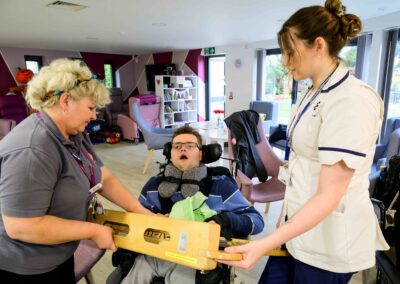Connecting with patients through the power of music
As Hospice Care Week comes to an end, we look at one of the more unique services St Elizabeth Hospice offers, using music to connect with patients and loved ones.
St Elizabeth Hospice provides a range of therapies to its patients, and their families and carers, including music and art therapy.
Music therapy is all about the use of music to support people and help them cope with day to day life. It has been proven to be very effective in difficult situations when all other forms of communication have failed.
St Elizabeth Hospice’s music therapist, Ray Travasso, is passionate about music and the power it has to connect people.
He says: “Music therapy is all about connecting as it has the ability to cut through everything else. Music can stimulate the brain in a way that nothing else does.
“It makes memory connections and helps on an emotional level.”
Ray works part-time at St Elizabeth Hospice as a music therapist, working with individuals, groups and even setting up the hospice choir, comprising of staff, volunteers, patients and families.
He works with patients in day care, on the inpatient unit, with the Young Adult Group and children on song-writing, music-making, performance and emotional communication.
“I take music not to patients but make it with them. It’s about picking up on how people are feeling, their emotions; sometimes just on their breathing.
“It’s a charged atmosphere, working in a hospice. Music therapy is designed to channel that emotion in a secure way, to express the sadness and the joy in the lives of those teenagers, children and adults with whom we work.
“It is interesting the way in which music can make moments of connection.”
He recalls a time when he went in to the inpatient unit with a harp and visited a patient at the end of life.
“I sat by the patient’s bedside and began to gently play. After a short while, my music started to synchronise with his breathing. As I played ‘Country Roads’, he opened his eyes, looked up and smiled at me, something he hadn’t done for some time.
“I was able to tell his family that his last responses were smiles and connecting to music.”
Ray is interested in the way that music therapy works with the many different aspects of a person, for example: the neurological; the emotional; the social, spiritual and the physical.
Patients write songs for their children and grandchildren; record songs to leave as legacies; find ways of making music to express how they are feeling.
Families around a loved-one’s bedside will sometimes sing, connecting with each other again. Music can enable people to pray, reflect and meditate as well.
He adds: “Music has a motivation about it which enables us to do things we wouldn’t normally do.”
Ray remembers a patient with Downs Syndrome who got more exercise in her music sessions than she did at any other time in her daily life. He also explains how a patient with whom he was working, who had a left sided neglect, became very frustrated with her lack of ability to communicate:
“She became depressed with her circumstances, but when I dug a little deeper, I found out that she had loved being in her church choir and that ever since she had stopped going, she had felt left out.
“We sang hymns together and recorded them singing ‘Amazing Grace’, harmonising together which she now has. It very much is an expression of her faith.
“This lady cannot speak a whole sentence but she is able to sing a whole musical phrase. This is because different neural pathways are in use when singing.”
As well as music therapy, St Elizabeth Hospice also offers art therapy, complementary therapies to help patients and families with the emotional aspects of coping and living with a progressive illness.
To find out more about St Elizabeth Hospice and its services, click here



